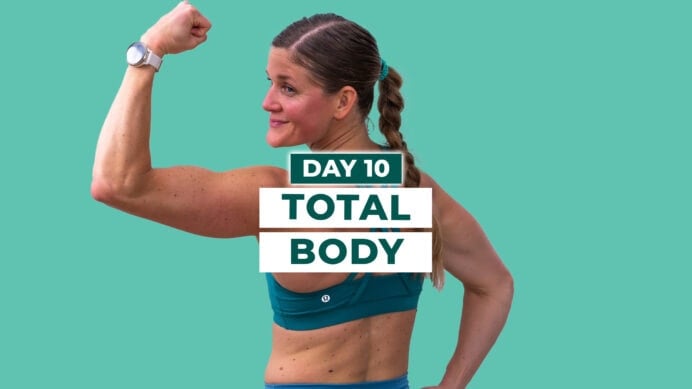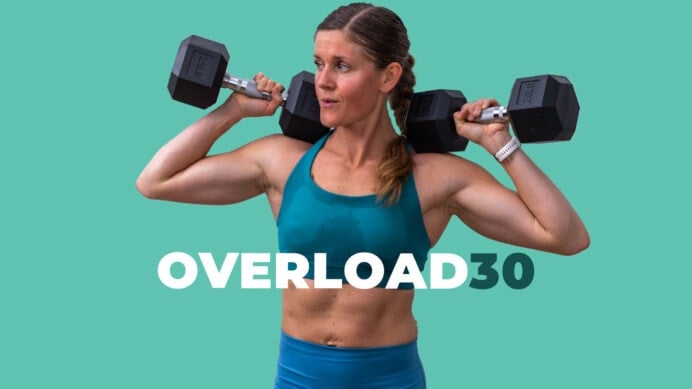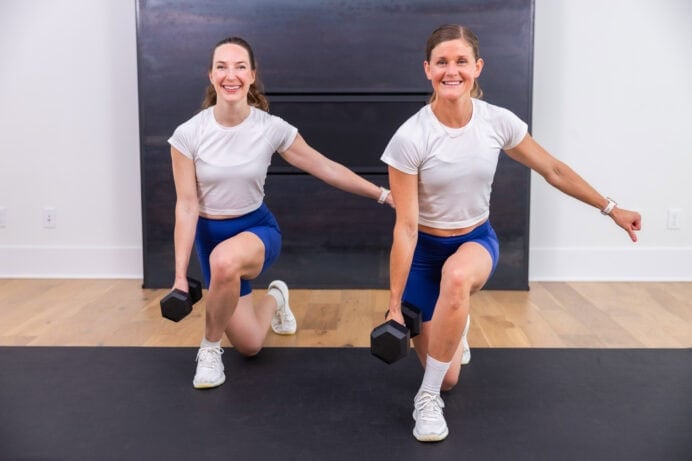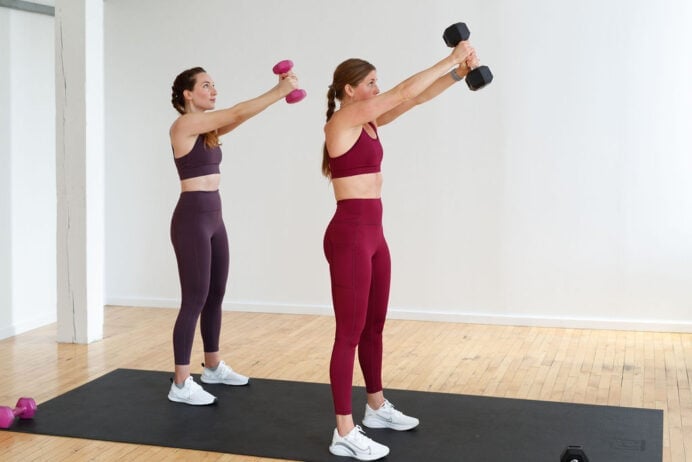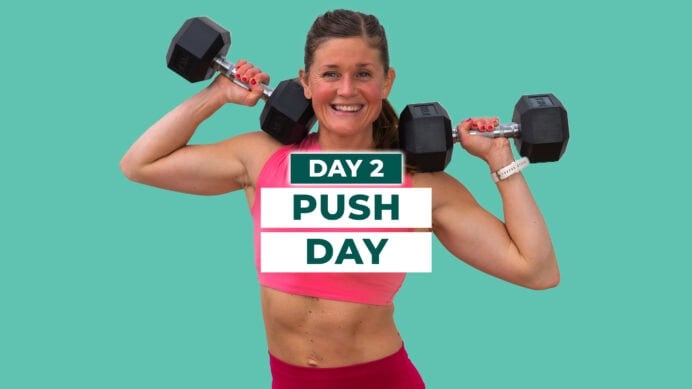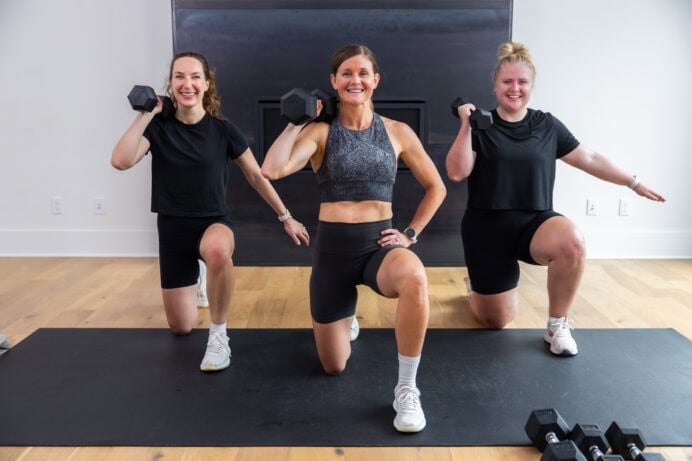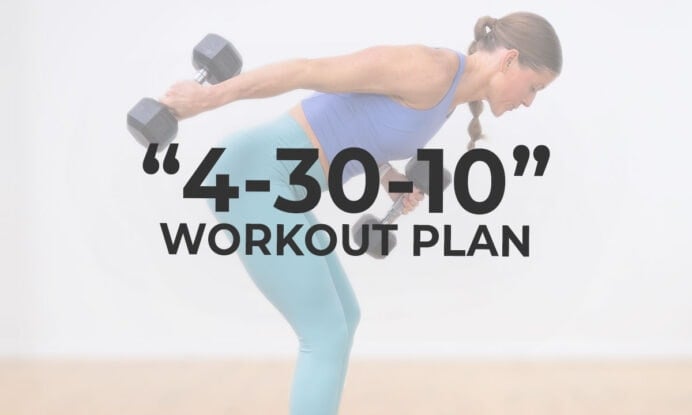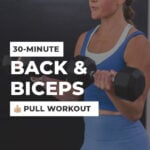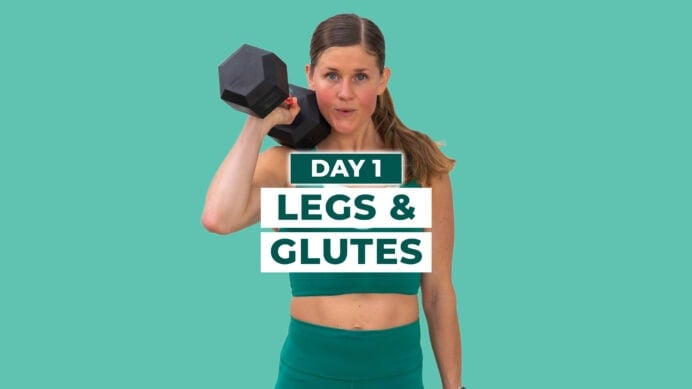
30-Minute Back and Bicep Workout (Overload 30 Day 9)
Challenge your upper-body pull muscles with this back and bicep workout. Each arm circuit includes three upper-body exercises, repeated times three sets for maximum muscle building. This is the ultimate dumbbell arm workout for defined back and biceps at home.
This is DAY NINE of my Overload 30 Program.
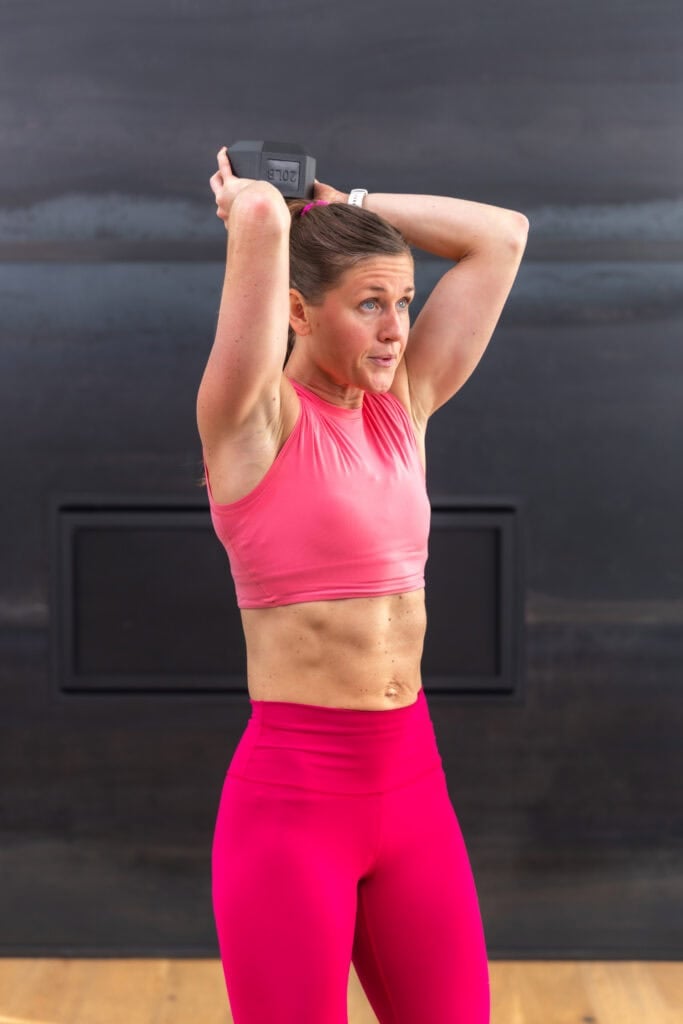
LET’S GET STARTED
Download Your FREE Workout Plan Here
It’s day nine of my 2-Week Overload 30 Program and guess what? It’s another upper-body day focused on the back and biceps!
Just like we did on Overload 30 Day 7, today’s upper-body pull workout is all about those strict sets. You’ll perform each upper-body pull exercise back-to-back consecutively. To really burn things out and build those muscles, we’re finishing with a full minute strip set.
Strict set training is really effective for making your muscles stronger. Doing the same exercise repeatedly really puts the pressure on those specific muscles, which makes them adapt and grow.
This back and bicep workout has some of my favorite moves for targeting those pulling muscles in your upper body. When you grab your dumbbells, don’t be shy with the weight. You should feel like those last 2-3 reps are a real struggle, but make sure you’re not sacrificing your form.
Workout Overview
Build strong arms at home with this dumbbell back and biceps workout.
I suggest doing this pull workout once a week as part of a well-rounded workout routine.
Workout Equipment:
Medium to Heavy Pair of Dumbbells. We’re using 15-30 lbs. Optional bench, pull-up bar and long loop resistance band if needed (discount code: NML).
Workout Instructions:
Follow along with the guided Back and Bicep Workout on YouTube, led by me — your certified personal trainer, Lindsey Bomgren.
Your Workout Looks Like This:
- 3 Strict Set Circuits (Back, Biceps and Combo)
- Timed Intervals (40 seconds of work, 20 seconds rest for strict sets and 60 seconds for strip sets)
- Strict Set Into Strip Set Format (repeat each strength exercise x 2 sets, back-to-back sets followed by a 60 second strip set burnout)
- Start with a 1-minute buy in exercise and end with a 2-minute HIIT finisher
Workout Outline
1-MINUTE BUY IN:
CIRCUIT ONE:
CIRCUIT TWO:
CIRCUIT THREE:
HIIT FINISHER:
- Heisman Runners
- Loaded Squat Jacks
1. Pull Up
Targets: Latissimus dorsi (lats), erector spinae, trapezius (traps), biceps, pectoralis major and minor (chest) and core.
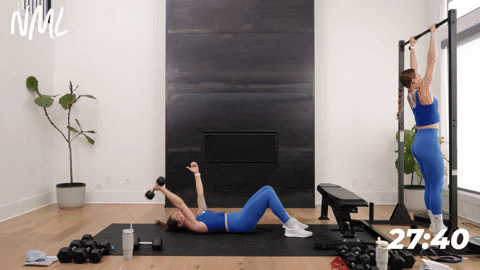
How to Do a Pull Up
- Start standing underneath your pull-up bar, feet hip-width apart, neck and shoulders relaxed.
- Reach up and grip the pull-up bar with your palms facing away from your body (overhand grip), hands slightly wider than shoulder-width distance apart.
- Allow your body to hang freely with your arms fully extended.
- Initiate the pull up by squeezing your shoulder blades together and pulling your chest towards the bar. Keep your elbows pointed downward throughout the movement.
- Continue to pull your body, pulling your chest up until your chin is above the bar, or as high as you can comfortably go. Keep your core engaged and your body straight throughout the movement.
- Slowly lower yourself back down to the starting position, extending your arms fully.
Modification: Option to perform assisted pull-ups with a long loop resistance band. Or perform dumbbell pullovers or single arm dumbbell pullovers.
2. Incline Plank and Row
Targets: Latissimus dorsi (or lats), upper back, chest, shoulders, arms and core.
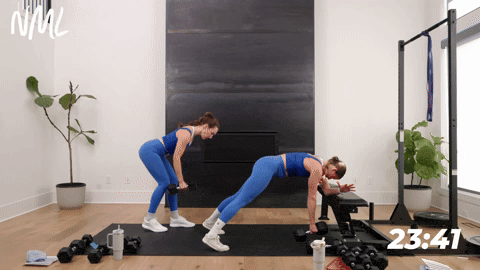
How to Do an Incline Plank and Row
- Start in front of a bench, box or couch. Place one dumbbell on the ground below your right arm. Brace your left forearm horizontally on the bench, shoulder stacked over elbow. Then step both feet back, finding an elevated high plank position.
- Gripping the dumbbell in your right hand, pull your right elbow to your right hip (performing a renegade row, or plank back row).
- Extend your arm, lowering your dumbbell towards the ground and returning to the starting position.
Modification: Perform standing single arm bent-over rows.
3. Supine Bicep Curl
Targets: The biceps brachii (the front of your arms). This move hits both heads of the biceps muscle.

How to Do a Supine Bicep Curl
- Start standing, feet shoulder-width apart and core engaged. Hold a dumbbell in each hand at your sides, palms facing outward (underhand grip or supinated grip).
- Exhale, squeezing the biceps muscle to curl the weights up to shoulder-height. Think about keeping your elbows tucked into your sides and your shoulder blades pulled down.
- With control, slowly lower the dumbbells down to your sides. Return to the starting position and repeat.
4. Hammer Curl
Targets: The long head of the bicep as well as the brachialis (another muscle in the upper arm located at the elbow joint) and the brachioradialis (forearm muscles).
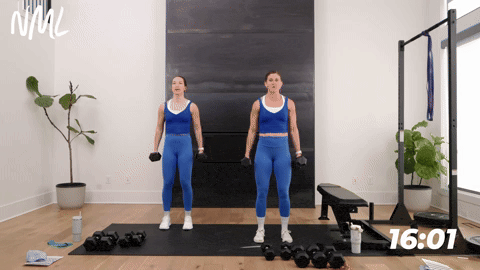
How to Do a Hammer Curl
- Start standing, feet shoulder-width apart, core engaged. Hold a dumbbell in each hand at your sides, palms facing in towards each other (hammer curl grip, or neutral grip).
- Squeeze your bicep muscle to curl the weights up to your shoulders. Keep the upper arms stationary as you curl.
- Hold for a moment before lowering the dumbbells down with control, returning to the starting position.
5. Bird Dog Wide Back Row
Targets: Upper arms, lower back, lats, glutes, hamstrings, abs and core.

How to Do Bird Dog Wide Back Row
- Find a quadruped position on a stable bench. Place your knees hip-width apart and your hands firmly on the bench, about shoulder-width apart. Engage your core. Place one dumbbell horizontally on the bench in front of you.
- Find a bird dog position by sending your right leg back, floating it off the bench.
- Perform a single arm wide row by grabbing the dumbbell with your left hand and pulling the dumbbell up and out to the side. Elbow goes wide, stopping when it’s parallel to your shoulder. The dumbbell in your left hand should now be parallel to the floor.
- Reverse the movement by straightening your arm to lower the dumbbell down towards the box with control.
Modification: Omit the bird dog position and perform a wide back row from the ground. Find a quadruped position, keeping both knees planted on the ground. Place a dumbbell horizontally in front of your right leg. Grab the dumbbell with your left hand and perform wide single arm rows, keeping both knees on the ground throughout the movement.
6. Wide Bicep Curl
Targets: Targets the long (outer) head of the biceps and the short (inner) head of the biceps.
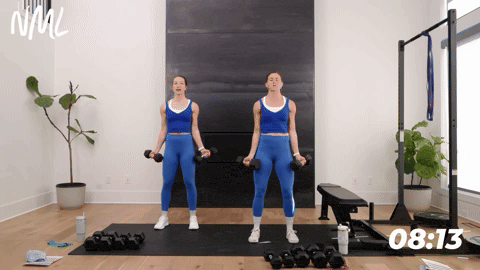
How to Do a Wide Bicep Curl
- Stand with your feet shoulder-width apart, core engaged. Hold a dumbbell in each hand at your sides, palms facing outward (underhand grip or supine curl). Keep the elbows tucked in close to the hips.
- Perform a wide bicep curl by extending the arms out wide as you curl the weights up to shoulder-height.
- With control, slowly lower the dumbbells down to your sides.
7. Face Pull
Targets: Rear deltoids, rhomboids, middle trapezius (upper back) and core.
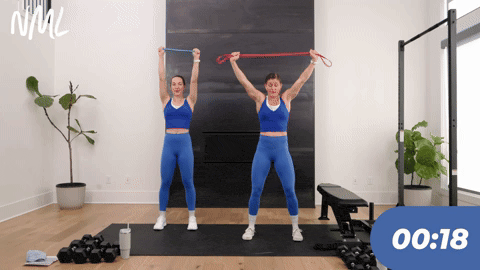
How to Do a Face Pull
- Start standing with your feet shoulder-width apart, core engaged. Hold each end of a resistance band, pulling the band to generate tension across the band.
- Hold the band directly overhead, keeping a soft bend in the elbows. Palms are facing out.
- Squeeze your shoulder blades together and slowly pull the band toward your chest.
- Pause for a moment and return to the starting position, sending the arms back overhead. Focus on your form, squeezing the shoulder blades together as you pull the band towards your face.
FAQs
Strength training the back and biceps together is beneficial because many exercises that target the back also engage the biceps. Working them together is an efficient and effective way to train both muscle groups. This combination leads to greater muscle growth and promotes overall strength.
A general guideline for strength training the back and biceps is to perform 3-5 sets of 8-12 reps per exercise. This supports both muscle hypertrophy (growth) and strength gains. If you’re a fitness beginner, start with 3 sets of 10-12 reps.
Overload 30: FREE 2-Week Progressive Overload Workout Plan
A 2-week progressive overload workout program designed to build muscle in 30 minutes a day.
If you liked these arm exercises, download the FREE 2-Week Progressive Overload Workout Plan.
Up Next:
See AllPin This Workout: Back and Bicep Exercises

This post includes affiliate links. I do earn a commission for products purchased using these links (at no additional cost to you). Thank you for supporting Nourish Move Love, making the content you see on this blog possible.










